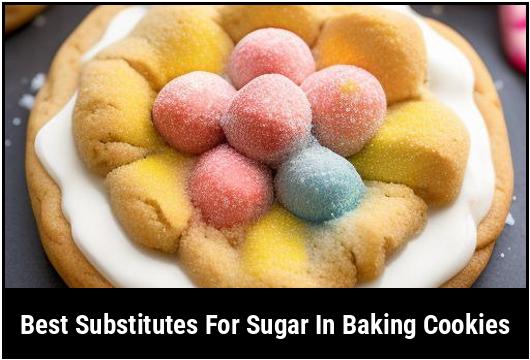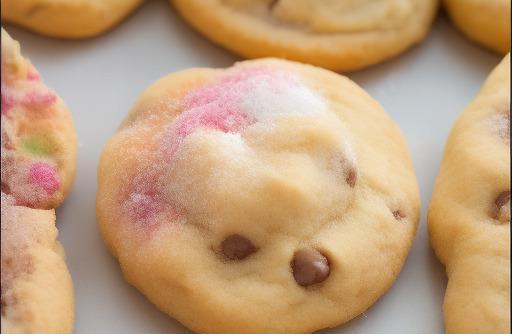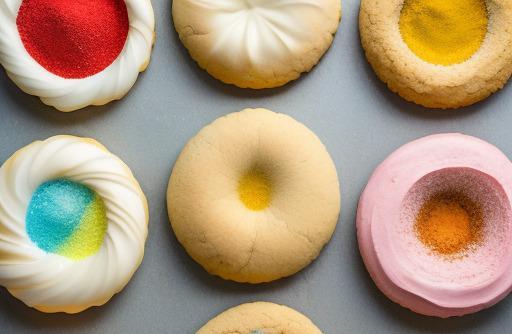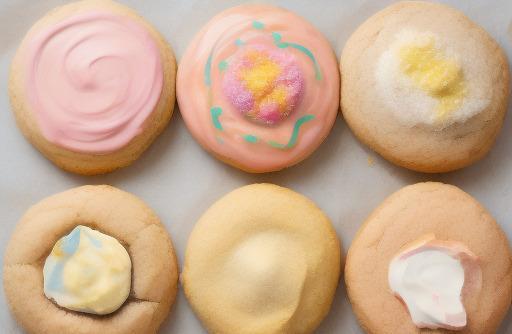Best Substitutes For Sugar In Baking Cookies

Baking cookies is a delightful activity that fills your home with the comforting aroma of freshly baked treats. However, if you are looking to reduce your sugar intake or have dietary restrictions, using traditional refined sugar in your cookies may not be an option. Luckily, there are several substitutes for sugar that can still provide sweetness and moisture to your cookies, without compromising on taste. In this article, we will explore the best substitutes for sugar in baking cookies, their benefits, and how to use them effectively.
Key Takeaways
- Traditional refined sugar can be substituted in baking cookies to reduce sugar intake or cater to dietary restrictions.
- Various natural sweeteners such as honey, maple syrup, and coconut sugar can be used as substitutes for sugar in baking cookies.
- Artificial sweeteners like stevia and erythritol can also be used as sugar substitutes.
- When using substitutes, it is important to consider their properties and adjust the recipe accordingly.
Why You Need A Substitute For Sugar In Baking Cookies
There are several reasons why you might want to seek alternatives to traditional refined sugar in your cookie recipes.
1. Health Concerns
Sugar consumption has been linked to various health issues, including obesity, diabetes, and tooth decay. Using a sugar substitute allows you to enjoy cookies while reducing your overall sugar intake.
2. Dietary Restrictions
Some individuals have dietary restrictions that require them to avoid or limit sugar consumption. This includes individuals with diabetes, those following a low-carbohydrate or ketogenic diet, and people with certain food allergies or intolerances.
3. Flavor Enhancement
Substituting sugar in your cookie recipes can also add new flavors and depth to your creations. Natural sweeteners like honey or maple syrup can impart their unique taste, enhancing the overall flavor profile of your cookies.
Types Of Substitutes For Sugar In Baking Cookies

When it comes to substituting sugar in baking cookies, there are various options to choose from. The right substitute for your cookies depends on your dietary needs, flavor preferences, and the desired texture of your baked goods. Here are some commonly used substitutes:
- Natural Sweeteners:
- Honey
- Maple syrup
- Agave nectar
- Coconut sugar
- Artificial Sweeteners:
- Stevia
- Erythritol
- Fruit Purees:
- Applesauce
- Mashed bananas
- Date paste
Each type of substitute has its own characteristics, which can affect the texture and sweetness of your cookies. Understanding these properties will help you choose the best substitute for your baking needs.
Best Substitutes For Sugar In Baking Cookies
1. Honey
Honey is a natural sweetener produced by bees and is a popular substitute for sugar in cookie recipes. It provides sweetness, moisture, and unique floral notes to your baked goods. When using honey as a substitute, keep in mind that it is sweeter than sugar, so you’ll need to use less of it. As a general rule, replace one cup of sugar with half a cup of honey and reduce the liquid in your recipe by one-fourth of a cup.
Pro Tip: When measuring honey, lightly coat the measuring cup with cooking spray or oil. This will prevent the sticky honey from clinging to the cup, making it easier to measure accurately.
2. Maple Syrup
Maple syrup, made from the sap of maple trees, adds a rich and distinct flavor to cookies. It is a great substitute for sugar and imparts a delicious caramel-like taste. Replace one cup of sugar with three-fourths of a cup of maple syrup. Since maple syrup is liquid, you may need to reduce the overall liquid content of your recipe slightly.
Pro Tip: Look for pure maple syrup rather than pancake syrup, which often contains added sugars and artificial flavors.
3. Agave Nectar
Agave nectar is a natural sweetener derived from the sap of the agave plant. It has a lower glycemic index than sugar, making it a suitable choice for those managing their blood sugar levels. Use three-fourths of a cup of agave nectar for every cup of sugar in your recipe. As agave nectar is sweeter than sugar, you may need to adjust the overall sweetness of your recipe accordingly.
4. Coconut Sugar
Coconut sugar, made from the sap of coconut palm flowers, is a minimally processed sweetener. It has a rich caramel flavor and can be used as a one-to-one substitute for sugar. However, keep in mind that coconut sugar can darken the color of your cookies and yield a denser texture.
5. Stevia
Stevia is a popular zero-calorie artificial sweetener derived from the leaves of the stevia plant. It is extremely concentrated, so only a small amount is needed to achieve the desired sweetness. Stevia is available in powdered or liquid form, and it is important to follow the manufacturer’s instructions for substitution. Be aware that stevia may have a slight aftertaste, which can affect the overall flavor of your cookies.
6. Erythritol
Erythritol is another artificial sweetener that is often used as a sugar substitute. It is a low-calorie sweetener that does not raise blood sugar levels and is suitable for individuals following a low-carbohydrate or ketogenic diet. Erythritol has a similar sweetness to sugar, and you can use it in a one-to-one ratio for sugar in your cookie recipes. It also provides a pleasant cooling sensation when eaten.
Choosing The Right Substitute For Sugar In Baking Cookies

When deciding on the best substitute for sugar in your cookie recipes, there are a few factors to consider:
1. Sweetness Level
Different substitutes have varying levels of sweetness. For example, honey and maple syrup are sweeter than sugar, while stevia and erythritol are much sweeter. Consider the desired level of sweetness for your cookies and adjust the quantity of substitute accordingly.
2. Flavor Profile
Substituting sugar can introduce new flavors to your cookies. Natural sweeteners like honey and maple syrup add their distinct taste, while artificial sweeteners like stevia and erythritol have a more neutral flavor. Consider how the flavor of the substitute will complement the other ingredients in your recipe.
3. Texture
Sugar does more than add sweetness to cookies; it also helps with moisture retention and texture. When using substitutes, you may experience slight variations in the texture of your baked goods. Experiment with different substitutes to find the one that yields the desired texture for your cookies.
4. Baking Temperature
Some substitutes may have different heat tolerances compared to sugar. For example, honey can brown more quickly in the oven due to its natural sugars. Consider the baking temperature and duration when choosing a substitute and make the necessary adjustments as needed.
Cooking With Substitutes For Sugar In Baking Cookies
When using substitutes for sugar in your cookie recipes, it is important to make the necessary adjustments to ensure successful baking. Here are some tips to keep in mind:
1. Adjust Liquid Content
Many sugar substitutes, such as honey and maple syrup, are in liquid form. This means you’ll need to reduce the overall liquid content of your recipe slightly. For each cup of sugar you replace, reduce the liquid by one-fourth of a cup.
2. Add Texture Enhancers
Since sugar adds moisture and texture to cookies, you may need to add additional ingredients to compensate for the loss of these properties when using substitutes. Common texture enhancers include applesauce, mashed bananas, or yogurt. These ingredients not only add moisture but also provide natural sweetness.
3. Enhance Flavor
To amplify the flavor profile of your cookies when using sugar substitutes, consider adding complementary ingredients. For example, using cinnamon or nutmeg can enhance the taste of cookies made with maple syrup, while adding vanilla extract can add depth to cookies made with stevia.
4. Adjust Baking Time And Temperature
Some substitutes may require adjustments to baking time and temperature due to their different properties. Keep a close eye on your cookies while they bake and make sure to test for doneness using the toothpick test or by gently pressing the cookies to ensure they are done.
Recipes Using Substitutes For Sugar In Baking Cookies

Now that you are well-versed in the various substitutes for sugar, here are a couple of delicious cookie recipes that you can try:
1. Honey Oat Cookies
Ingredients:
- 1 cup rolled oats
- 1 cup almond flour
- 1/2 cup honey
- 1/4 cup melted coconut oil
- 1 tsp vanilla extract
- 1/2 tsp baking soda
- 1/4 tsp salt
- Optional: 1/2 cup chopped nuts, dried fruits, or chocolate chips
Instructions:
- Preheat your oven to 350°F (175°C) and line a baking sheet with parchment paper.
- In a large bowl, combine the almond flour, rolled oats, baking soda, and salt.
- In a separate bowl, whisk together the honey, melted coconut oil, and vanilla extract.
- Add the wet ingredients to the dry ingredients and mix until well combined. If desired, stir in the optional add-ins.
- Use a cookie scoop or a tablespoon to drop rounded portions of dough onto the prepared baking sheet.
- Bake for 12-15 minutes or until the edges are golden brown.
- Allow the cookies to cool on the baking sheet for 5 minutes, then transfer them to a wire rack to cool completely.
2. Maple Pecan Cookies
Ingredients:
- 1 1/2 cups all-purpose flour
- 1 cup chopped pecans
- 1/2 cup unsalted butter, softened
- 1/2 cup maple syrup
- 1 tsp baking powder
- 1/4 tsp salt
- Optional: 1/2 cup chocolate chips
Instructions:
- Preheat your oven to 350°F (175°C) and line a baking sheet with parchment paper.
- In a large bowl, cream together the softened butter and maple syrup until light and fluffy.
- In a separate bowl, whisk together the flour, baking powder, and salt.
- Gradually add the dry ingredients to the butter mixture, mixing well after each addition. If desired, stir in the chopped pecans and chocolate chips.
- Drop rounded portions of dough onto the prepared baking sheet, spacing them about 2 inches apart.
- Bake for 10-12 minutes or until the edges are lightly golden.
- Allow the cookies to cool on the baking sheet for a few minutes, then transfer them to a wire rack to cool completely.
Storage And Shelf Life Of Substitutes
When storing cookies made with sugar substitutes, keep in mind that they may have a slightly different shelf life compared to traditional sugar cookies. Here are some general guidelines:
- Honey, maple syrup, and agave nectar-based cookies tend to have a shorter shelf life due to their higher moisture content. Store these cookies in an airtight container at room temperature for up to 4-5 days.
- Cookies made with artificial sweeteners like stevia and erythritol tend to have a longer shelf life due to their low moisture content. Store these cookies in an airtight container at room temperature for up to 1-2 weeks.
To prolong the shelf life of all cookies, you can also store them in the refrigerator or freezer. Just make sure to seal them properly to prevent moisture absorption or freezer burn.
Conclusion
Substituting sugar in baking cookies can be a great way to reduce sugar intake, cater to dietary restrictions, or enhance the flavor profile of your treats. By choosing the right substitute and making the necessary adjustments, you can still enjoy delicious and satisfying cookies. Experiment with different substitutes and have fun exploring new flavors and textures in your baking adventures.
Remember, each substitute has its own unique properties, so it may take some trial and error to find the perfect substitute for your specific recipe. Whether you opt for natural sweeteners like honey or maple syrup, artificial sweeteners like stevia or erythritol, or even fruit purees, be sure to follow the recommended measurements and make adjustments as needed. Happy baking!
FAQS
What Are Some Common Best Substitutes For Sugar In Baking Cookies?
Some common substitutes for sugar in baking cookies include honey, maple syrup, Stevia, coconut sugar, and dates.
Can I Use Honey As A Sugar Substitute In Cookie Recipes?
Yes, honey is a great sugar substitute for cookies as it will add moisture and sweetness to the dough. You will need to use about half the amount of honey as you would sugar.
Is Coconut Sugar A Good Substitute For White Sugar In Baking Cookies?
Yes, coconut sugar can be used as a 1:1 substitute for white sugar in cookie recipes. It has a caramel-like flavor and can also add a slight nuttiness to the cookies.
What About Using Artificial Sweeteners In Cookie Recipes?
Artificial sweeteners like Stevia and Splenda can be used in cookie recipes, but they do not provide the same texture as sugar. You may need to adjust other ingredients, such as the amount of flour or leaveners, to get the right consistency.
Can I Use Fruit Purees As A Sugar Substitute In Baking Cookies?
Fruit purees like applesauce, mashed bananas, and dates can be used as sugar substitutes in cookie recipes. However, they will change the texture of your cookies and make them more dense and gooey. You may need to adjust other ingredients to balance the moisture levels.
Sources
About the Author Jenny
I'm Jenny, a housewife with an unwavering passion for food. My culinary journey began with my grandmother's kitchen, and it's now a full-fledged food blog. I've turned my love for cooking into a creative outlet, sharing recipes and stories with a global community of fellow food enthusiasts. It's proof that being a housewife can also mean pursuing your passions and savoring life's delectable moments.
